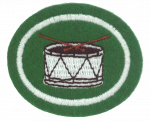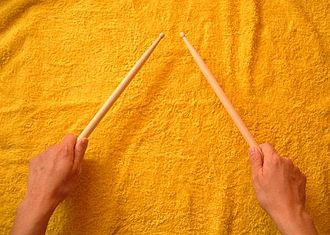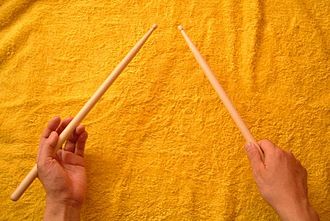Especialidades JA/Tamboreo y percusión/Respuestas
| Tamboreo y percusión | ||
|---|---|---|
| Asociación General
|
Destreza: 2 Año de introducción: 2006 |
|
Requisitos
|
La especialidad de Tamboreo y percusión es un componente de la Maestría Recreación. |
1
a. La iglesia local
b. La comunidad
2
3
Rolls
Single Stroke Roll Rudiments
The single-stroke roll consists of alternating sticking (i.e., RLRL, etc.) of indeterminate speed and length.
Drag rudiments
| No. | Name | Notation | Description |
|---|---|---|---|
| 31. | Drag | A drag consists of two consecutive notes played by the same hand (either RR or LL). This is similar to the diddle, except that by convention diddles are played the same speed as the context in which they are placed, where drags are played at twice the speed as the context in which they are placed. For example, if a sixteenth note passage is being played then any drags in that passage would by definition be thirty-second notes, where diddles would be sixteenth notes. Drags can also be played as grace notes. When played as grace notes on timpani, the grace notes are alternated (rlR, lrL). &
Continuously playing alternating drags (or diddles) results in a double-stroke roll. A similar rudiment is the ruff, which is a note with three grace notes, but they are usually alternated & | |
| 32. | Single Drag Tap | 
|
A single drag tap is two alternating notes where the first note has drag grace notes and the second is accented. |
| 33. | Double Drag Tap | 
|
A double drag tap is a single drag tap with another grace note drag before it. |
| 34. | Lesson 25 | 
|
A lesson 25 is three alternating notes where the first note has drag grace notes and the third is accented. |
| 35. | Single Dragadiddle | 
|
A single dragadiddle is a paradiddle where the first note is a drag. |
| 36. | Drag Paradiddle #1 | 
|
The first drag paradiddle is an accented note followed by a paradiddle with drag grace notes on the first note. |
| 37. | Drag Paradiddle #2 | The second drag paradiddle is two accented notes followed by a paradiddle with drag grace notes on the second accented note and the first note of the paradiddle. | |
| 38. | Single Ratamacue | 
|
A single ratamacue consists of four notes where the first note has drag grace notes and the fourth is accented. |
| 39. | Double Ratamacue | 
|
A double ratamacue consists of a single ratamacue with a drag before it. |
| 40. | Triple Ratamacue | 
|
A triple ratamacue consists of a single ratamacue with two drags before it. |
4
Songs that are marches are written in either 2/4, or more commonly, 4/4 time. When marching to such a song, the left foot leads and always hits the ground on an odd beat, while the right foot hits the ground on an even beat. Count the beats in your head as you march, "1, 2, 3, 4, 1, 2, 3, 4" etc. The left foot touches the ground on each 1 and 3. The right foot touches on each 2 and 4. If you find you are out of step, a quick hop (where the feet do not cross one another) can quickly get you back into step. But staying in step is a lot easier than getting back in step once you're out, so pay attention!
The outreach program will be something like a parade in which your drum corps marches. This will call for a class A uniform, so make sure it is clean and pressed!
5
Drum straps are basically a strap across your body. Drum carriers are frontal LINK: http://www.google.com/products/catalog?q=snare+drum+harness&hl=en&prmd=imvns&bav=on.2,or.r_gc.r_pw.,cf.osb&ion=1&biw=1280&bih=642&um=1&ie=UTF-8&tbm=shop&cid=9962442093029923537&sa=X&ei=Ig0aT5zKLOLs2AXduMX8Cw&ved=0CJkBEPICMAQ
6
- 1. Single Stroke Roll
- 2. Multiple Bounce Roll
- 3. Double Stroke Open Roll
- 4. Five Stroke Roll
- 5. Single Paradiddle
- 6. Flam
- 7. Drag
Each rudiment as listed in the order above indicates the level of advancements once one begins to learn the rudiment families. Each rudiment builds on the knowledge of prior rudiments. With the addition of strokes, accents, and a combination of two or more rudiments, new rudiments are developed. Learning how to play rudiments in this fashion will assist the player in understanding the basic concepts of drumming.
7
8
Open, closed, open is a technique of playing snare drum rudiments, especially used during auditions.
Open, closed, open technique consists of beginning the rudiment very slow and controlled, speeding up evenly until at the maximum speed for the drummer, then slowing back down after maintaining that speed. Optimally, the drummer should end on the opposite hand as started, in case of alternating rudiments such as paradiddles. Also, the speed ended at should be approximately the same speed as the drummer began.
9
In the past, snares were typically carried with slings, and due to the discomfort of this angle for the left hand, traditional grip was created. Most modern snare drums have rigid over-the-shoulder harnesses that hold the drum with the playing surface parallel to the ground, which affords the option of performing with matched grip. The term matched grip is used because both hands are in the same position (matched). However there are many groups that are returning to a slight tilt in order to make using traditional grip more comfortable for the players.
10
Snare drum sticks may be designed for use in particular performance contexts. Sticks that are smaller in diameter or balanced farther towards the tip may be intended for orchestral playing that requires fine control and soft dynamics. Sticks for street playing (e.g. drum corps and marching bands) are almost always thick and weighty, to promote extended production of sound at extreme dynamics.
Easy Answer:
Drum Corp: Heavy and thick
Drum Set: Light and thin usually with laminated top
11
There are five primary sections that make up a drum corp/drumline. They are as follows: Cymbal Section, Snare Line, Tenor Line(including Tri/Quads/Quints), Bass Line, and the Pit.
Note: Some drum corps/drumlines may opt to use a multi-tenor setup instead of having a single tenor, but they would still fall under the tenor line catergory.
12
Snare Drums
Snare parts are typically unison and provide the center rhythm of the drumline. The snare drum line is the center of tempo in the ensemble, and the "center snare", a position typically held by the most experienced snare drummer, is responsible for maintaining the tempo. When rehearsing or performing, the center snare may "tap off" the ensemble, setting the tempo with a solo rhythm.
Tenor Drums
Contemporary tenor drums (also called toms, tri-toms, quads, quints, squints, or sextets) are single-headed tonal drums. There are usually four to six drums in a set, but there can be as few as one or as many as seven. Tenor players add pitch variety to the drumline with drums of different sizes and tuning.
Cymbals
Marching cymbals are typically pairs of crash cymbals played in a variety of ways. Cymbals are bronze with leather carrying straps. Players in cymbal lines may all carry the same size and type of cymbal, or a variety of instruments may be used. Cymbals are played being held before the body, in unison or split parts. In addition to being played by the cymbalists, snare drummers may play on the cymbals as ride cymbals or like hi-hats, thus there is typically a minimum of one cymbalist for every two snare drummers. Cymbals are also used for visual effects due to their reflectiveness while twirling or spinning them. Many contemporary field ensembles do not utilize a cymbal line, as cymbals are played in the front ensemble.
Bass Drums
Marching bass drums are most frequently used as tonal drums split between several percussionists. Each drummer plays a unique part, though the entire bass drum part is conceived as a whole. Marching bass drums, which produce the deepest sound in the battery, are larger drums carried on harnesses with the heads facing the front and back sidelines. The musicians carrying the bass drums typically line up in size order. Bass drummers use mallets with rounded or cylindrical heads often made of hard felt. Small bass drum lines typically consist of four or five members to ensure enough for a melody, and large lines can have eight or more drummers. Sometimes, in smaller bands, one may see only 2 or 3 bass drummers perform, when this happens, sometimes a bass drummer is required to play 2 or 3 bass drum parts to ensure full sound. In very small bands, one may only see one bass drum witch takes the place of 3 to 4 bass drums.
Pit
Pit plays all the percussive instruments in the band. The pit usually plays the marimba, vibraphone, xylophone, chimes, electric keyboard, and bells. They also play the suspended cymbal and other "auxiliary" instruments such as bongos, tambourine, cowbell, anvil, and bass drum and gong. The pit usually is the main melody in marching band, especially in drum corp. The keyboards have a different "utensil" for making sound. They use a mallet which is held the same way as a drum stick. It is also possible to hold two mallets in each hand, four mallet technique, and three mallers in each hand, very rare but the six mallet technique. More info will be provided when the PERCUSSION HONOR is made.
13
14
There are different sizes of drum sticks for each situation, designated by a letter and number, e.g. 2b and 5b are thicker, while 5a and 7a are smaller. The number in the designation corresponds to the length of the stick, with smaller numbers being longer sticks, and the letter corresponds to the diameter or gauge of the stick, with the further along the alphabet the thicker the stick, so "b" is larger than "a".
15
For Practice you would use a Practice pad.
References:
- Drums for Dummies by Jeff Strong (Paperback - Sep 29, 2001)
- Drum Corps International (www.dci.org)
- Drum Corps Ministry Manual (Paperback - 2008)
- by Gregory M. Carmichael
- AdventSource (www.adventsource.org)
- (Direct link to Manual)
- catalog: #001073
- Han Baker: Pathfinder and Percussionist
References
- ↑ 1.0 1.1 Nasatir, Cary. "Too Many Rudiments?". Conn-Selmer Keynotes. http://www.keynotesmagazine.com/article.php?uid=120. Retrieved February 3 2008.
- Categoría: Tiene imagen de insignia
- Adventist Youth Honors Answer Book/Honors/es
- Adventist Youth Honors Answer Book/es
- Adventist Youth Honors Answer Book/Skill Level 2/es
- Categoría: Libro de respuestas de especialidades JA/Especialidades introducidas en 2006
- Adventist Youth Honors Answer Book/General Conference/es
- Adventist Youth Honors Answer Book/Recreation/es
- Adventist Youth Honors Answer Book/Recreation/Primary/es
- Adventist Youth Honors Answer Book/Stage 0/es
- Adventist Youth Honors Answer Book/Recreation Master Award/es
- Adventist Youth Honors Answer Book



